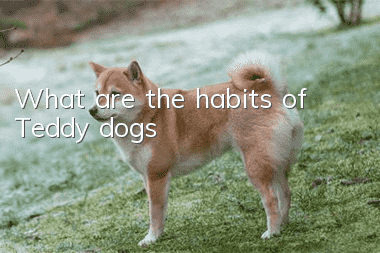What are the habits of Teddy dogs?

What are the habits of Teddy dogs? Teddy dogs like to live in groups and have a clear hierarchy in the group. Interaction with people is a natural habit of Teddy dogs, and its degree often depends on the degree of "imprint" of contact with people at the age of 3 to 7 weeks. Teddy dogs have a sense of territory and territory marking. They center on themselves, mark the territory with their own scent, and update it frequently.
1. Teddy dogs have hierarchical habits:
Teddy dogs are gregarious by nature, but they have a clear hierarchy in the group. In Teddy dog breeding farms, rural or suburban Teddy dog groups, there is always one head dog (usually an old Teddy dog) that dominates and governs the entire group. How does a high-ranking or senior Teddy dog show its level advantage? It is usually expressed by the following specific actions: such as allowing it but not allowing the other party to inspect its Teddy dog's reproductive organs; Only buy the place where the dog has urinated; the other party can shake his head, wag his tail, play naughty in front of the head dog, or retreat, sit down or lie down. Only when the head dog leaves can he stand; after the level advantage is clear , the hostility is eliminated and we start to become friends. Teddy dogs will show the same gesture to their parents.
2. Teddy dogs have the characteristics of being easy to get along with:
Interaction with people is a natural habit of Teddy dogs, but its degree often depends on the degree of "mark" contact with people at the age of 3 to 7 weeks. If a Teddy dog is only with its parents or other Teddy dogs in the first two months of its life, and not with people, or does not really get to know people gradually, it will stay away from people throughout its life and will be difficult to train. If it is caressed by people since it is born, it will realize that people are friends and partners with whom it can play, and it will be familiar with people's smell, be kind to people, and can be easily trained. It is very important to pay attention to the marking stage when selecting and training a Teddy dog.
3. Teddy dogs have a sense of territory and territorial marking:
Like other animals (such as cats, birds and rodents), Teddy dogs have a sense of territory, centering on themselves, marking the territory with their own scent, and updating it frequently. A territory can belong to only one or two Teddy dogs, or to the entire Teddy dog group. If a foreign teddy dog breaks into a teddy dog's territory, it will act very cautiously. If the owner of the territory (teddy dog) comes, the intruder will not dare to look at it and pretend to be busy with other things to avoid interacting with the territory. The teddy dogs fought and then left. So, how does a Teddy dog mark its territory? It usually fixes some points along its usual walking route. For example, when a male Teddy dog goes out for a walk, he always pees a small amount of urine on some fixed tree trunks, under street lights or in corners. The smell of one Teddy dog can let another Teddy dog know the territory, gender, age and health of this Teddy dog.
- Is it better for Dogo dogs to have their ears erect or cropped? A case of Dogo dog’s ear erection surgery will tell you
- What do dogs eat to protect their stomach? It is important to protect their stomach and treat gastrointestinal diseases in dogs.
- How to tell if your dog is fat? Is your dog overweight?
- How to train Tibetan Mastiff Four aspects teach you how to train Tibetan Mastiff
- Will your dog catch a cold if you blow the air conditioner? What should you do if your dog catches a cold if you blow the air conditioner?
- What should you pay attention to when your dog drinks water? Don’t be careless when it comes to your dog’s drinking water.
- The dog's mouth bites and shakes. Why does the dog's mouth occasionally shake and bite?
- How to cut a dog's hair? Do you know how to cut a dog's hair correctly?
- Can dogs eat raw eggs? Why can’t dogs eat egg whites?
- Common Dog Problems in Summer How to Deal with Different Dog Problems



